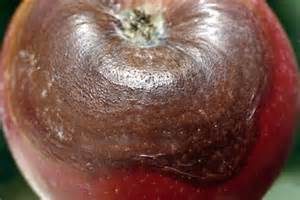Black rot is a disease caused by the fungus, Botryosphaeria obtusa, which can attack the fruit, leaves, and bark of any tree in the pomaceous family (apples, pears, quinces, medlars, hawthorn). Pome fruits are fleshy fruits that do not have a central stone, but are cored with small seeds. Identifying black rot early is important in stopping the spread of the fungus, as it also can be parasitic to weak or dead wood in other plants in your garden. [Note: A different species of fungus which affects grapes during hot, humid weather is also known as black rot.]
About a week or two after petals from your apple blossoms fall, you should start checking your upper leaf surfaces for little purple spots, which is an early indicator of black rot. Eventually, the middle of these purple spots will turn yellow or brown in color, as well as dry out, while the margins of the spot will remain purple. The shape of the spot may become irregular and the middle of the spot also might form pycnidia, which are small, black pimple-like fruiting bodies of the fungus. A heavily affected leaf will usually drop off.
Tree branches or limbs might contain cankers, or sunken in areas of bark that are reddish brown in color. When sap continues to ooze from a pruning cut, one of the causes may be black rot gaining a foothold in the wood. These areas can expand each year and cause the affected limb to die. At any sign of rot or canker on the wood, a biological mudpack is a great way to combat organically, prior to the drastic measure of pruning a badly infected limb.
Black rot is found on your fruit in usually only one spot, which can differentiate black rot from bitter rot. The original spot on your fruit can be from any break of the skin of the fruit, including insect injuries. Starting as a brown spot, the rot will most likely grow and possibly turn black. You might also see more pycnidia on the fruit during this time. The fruit can form concentric rings around the spot and the fruit will begin to turn leathery. As the fruit decays, dries and shrivels up, it will eventually become completely mummified.
Treatment of black rot is a year round process, that begins with building healthy soil and good tree maintenance during the winter.Black rot can overwinter, which means that it will lay dormant in your tree, bark, limbs, cankers and mummified fruit and survive until the next fruiting season. You should always clear or prune dead or decaying wood, as well as fallen debris or dead fruit from around your tree.
The best way to rid your trees of black rot is to cut out the offending areas or cankers during the winter. Make sure to dispose of these properly, either by disposing in trash bags, burning, or burying them. It is also important to take away all mummified fruit, for the same reason of limiting the spread of fungal spores. Additionally, when your tree is fruiting, you should remove fruit that is damaged or invaded by insects, so that the fungus will not spread there. While you could try organically-approved fungicides, such as copper-based sprays or lime sulphur, these are still quite harsh and should be considered a last resort. The best method is to keep a sanitary tree environment all year round and consistently remove all sources of fungus spores.
References:
http://extension.psu.edu/
http://www.gardeningknowhow.
http://www.ehow.com/info_
The Holistic Orchard by Michael Phillips The Organic Gardener’s Handbook of Natural Pest and Disease Control: A Complete Guide to Maintaining a Healthy Garden and Yard the Earth-Friendly Way (Rodale Organic Gardening Books)
http://www.forestryimages.org/
http://www.fruit.cornell.edu/
http://www.caf.wvu.edu/
